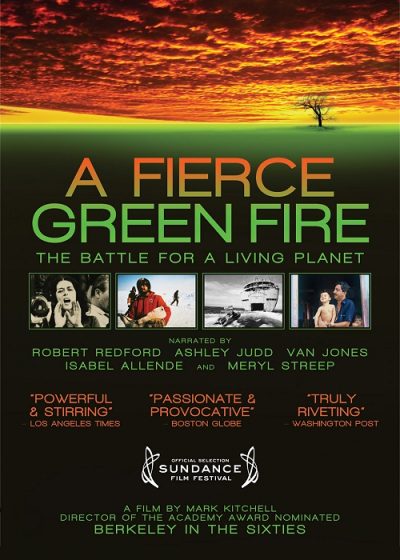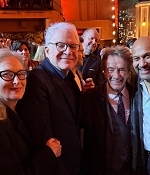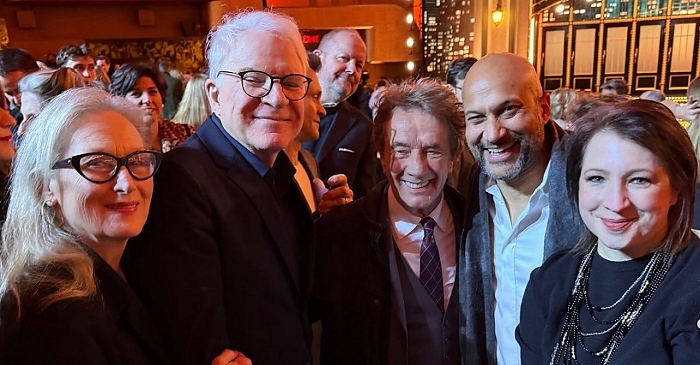|
Simply Streep is your premiere source on Meryl Streep's work on film, television and in the theatre - a career that has won her the praise to be one of the world's greatest working actresses. Created in 1999, we have built an extensive collection to discover Miss Streep's body of work through articles, photos and videos. Enjoy your stay.
|
Celebrating
25 years
of SimplyStreep
|
A Fierce Green Fire
April 20, 2012
· First Run Features
· 101 minutes
|

“A Fierce Green Fire” unfolds in five acts, each twenty-two minutes. E.O. Wilson, eminent biologist and advisor to the film, said focus on five of the most dramatic and important events and people. In developing those main stories and characters, we discovered each was emblematic of an era and a part of the environmental movement. So we devised an hourglass structure for each act. They begin with broader context. Then they focus in on the main story, more fully told. Finally they open up again to explore ramifications.
Act 1 focuses on the conservation movement of the ‘60s, David Brower and the Sierra Club’s battle to halt dams in the Grand Canyon. It grows out of three earlier battles to halt dams: Hetch Hetchy, which was lost; Dinosaur Monument, which was won; and Glen Canyon, which was sacrificed. Saving the Grand Canyon looks like a lost cause until David Brower places ads denouncing the dams. The IRS retaliates and the uproar becomes front-page news. Opposition grows so fast and furious that Congress bows to pressure – canceling and finally prohibiting dams. It is the biggest victory yet, a pivotal battle that brings the flowering of conservation. However, Brower is soon forced out of the Sierra Club. He is coming to a larger vision – just as Earth Day heralds a new environmental consciousness.
Act 2 looks at the new environmental movement of the ‘70s with its concerns about pollution, focusing on the battle led by Lois Gibbs over Love Canal. First we connect Rachel Carson and Silent Spring to the golden era of environmental legislation and groups like NRDC that arose to enforce regulations. But it takes Love Canal to put toxic waste on the map. Lois Gibbs leads angry housewives in a two-year battle to save their children from 20,000 tons of toxic chemicals. They are relentless, protesting and conducting health studies and demanding relocation, even taking EPA officials hostage until President Carter agrees to buy them out. However it is only the beginning. Reagan counterattacks. Grassroots activists fighting toxics in their own backyard arise all over the country. Environmental racism gives birth to an environmental justice movement.
Act 3 is about alternative ecology strands, with the main story being Greenpeace’s campaign to save the whales. We begin with going back to the land, building ecological alternatives and exploring renewable energy. Greenpeace brings together the anti-war and ecology movements. Putting themselves in front of harpoons to stop whaling launches Greenpeace on the wildest ride of any environmental group. Soon they are fighting on every front all over the world. Paul Watson, thrown out of Greenpeace for tossing a sealer’s club in the water, is reborn as Sea Shepherd and takes on whalers. Everyone comes together to campaign for a moratorium on whaling – one of environmentalism’s greatest victories. This act ends with the growth of green issues in Europe.
Act 4 explores global resource issues and crises of the ‘80s, focusing on the struggle to save the Amazon led by Chico Mendes and the rubber tappers. They fight ranchers and roads, then start a movement to establish extractive reserves. The pivotal battle is over a plantation called Cachoeira. Chico wins – but is assasinated. However his death proves to be the turning point, to reserves that now total a third of the Amazon. Yet relentless pressures threaten to turn it into a semi-desert. We expand to look at movements across the global south, from Chipko in India and Wangari Maathai’s Greenbelt Movement to water wars in Bolivia and arguments over equity and sustainability.
Act 5 concerns climate change. First we look at scientific origins. Then comes a twenty-year story of political frustration, from Rio to Kyoto to Copenhagen. We explore opposition; the movement’s difficulty in dealing with the issue; and the role of disasters like Hurricane Katrina in bringing it back. COP15 ends in failure and our focus shifts from top-down politics to bottom-up movements. Paul Hawken relates his Blessed Unrest revelation: two million groups working at the grassroots, humanity’s immune response. We turn to the future, explore environmentalism as civilizational transformation, reinventing the way we make and do everything – then close with hope and the realization that we have all become environmentalists. As Bob Bullard says, “There’s no Hispanic air. There’s no African-American air. There’s air! And if you breathe air – and most people I know do breathe air – then I would consider you an environmentalist.”









